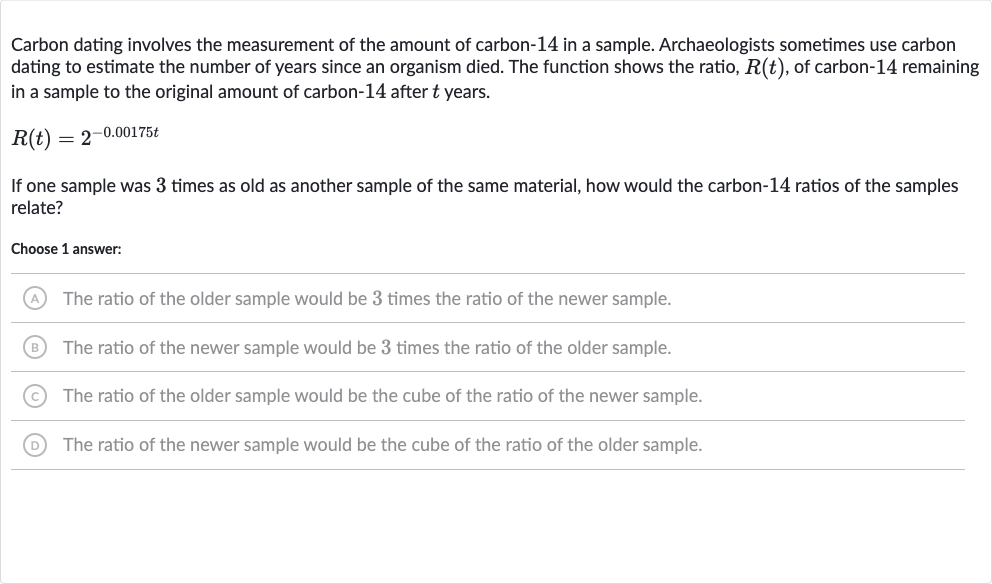AI tutor
Welcome to Bytelearn!
Let’s check out your problem:

Carbon dating involves the measurement of the amount of carbon in a sample. Archaeologists sometimes use carbon dating to estimate the number of years since an organism died. The function shows the ratio, , of carbon remaining in a sample to the original amount of carbon after years.If one sample was times as old as another sample of the same material, how would the carbon ratios of the samples relate?Choose answer:(A) The ratio of the older sample would be times the ratio of the newer sample.(B) The ratio of the newer sample would be times the ratio of the older sample.(C) The ratio of the older sample would be the cube of the ratio of the newer sample.(D) The ratio of the newer sample would be the cube of the ratio of the older sample.
Full solution
Q. Carbon dating involves the measurement of the amount of carbon in a sample. Archaeologists sometimes use carbon dating to estimate the number of years since an organism died. The function shows the ratio, , of carbon remaining in a sample to the original amount of carbon after years.If one sample was times as old as another sample of the same material, how would the carbon ratios of the samples relate?Choose answer:(A) The ratio of the older sample would be times the ratio of the newer sample.(B) The ratio of the newer sample would be times the ratio of the older sample.(C) The ratio of the older sample would be the cube of the ratio of the newer sample.(D) The ratio of the newer sample would be the cube of the ratio of the older sample.
- Understand Carbon Ratio Function: Understand the function for carbon ratio.The function gives us the ratio of carbon remaining in a sample to the original amount after years. We need to compare the ratios for two samples where one is three times as old as the other.
- Set Up Newer Sample Ratio: Set up the ratio for the newer sample. Let's call the age of the newer sample years. Then the ratio of carbon in the newer sample is .
- Set Up Older Sample Ratio: Set up the ratio for the older sample.The older sample is three times as old as the newer sample, so its age is years. The ratio of carbon in the older sample is .
- Simplify Older Sample Ratio Expression: Simplify the expression for the older sample's ratio. . This shows that the ratio of the older sample is the cube of the ratio of the newer sample.
- Choose Correct Answer: Choose the correct answer based on the relationship found.Based on the relationship , we can conclude that the ratio of the older sample would be the cube of the ratio of the newer sample. Therefore, the correct answer is (C).
More problems from Evaluate two-variable equations: word problems
QuestionGet tutor help
QuestionGet tutor help
QuestionGet tutor help
QuestionGet tutor help
QuestionGet tutor help
QuestionGet tutor help
QuestionGet tutor help
QuestionGet tutor help
QuestionGet tutor help
